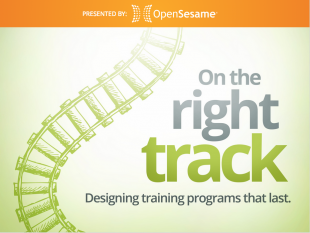My previous post in the “Marketing Your eLearning Initiative” series addressed ideas on how to use email as a method for advertising the launch of your program, new courses and positive experiences using the training. While digital communication is a great way to provide regular updates regarding your elearning program, signage can promote your overall training initiative and reinforce benefits of the program. Additionally, diversifying your communication methods, and where the communication occurs, increases the likelihood of the messaging being retained. ... [more]
On Tuesday June 3 at 10:00am PDT, we'll be providing you an exclusive look at the features and benefits of OpenSesame Plus in a 45-minute introductory webinar. OpenSesame's latest pricing solution, OpenSesame Plus, offers unlimited access to 2,500+ courses for one low price. The simple and affordable subscription model provides the training you need, when you need it, without having to worry about the cost per course. The catalog features more than 50 categories—from business skills and compliance, to software and technology—making OpenSesame Plus ideal for companies of any size with diverse training needs. ... [more]
Young adults are in a bit of a catch-22 these days. The majority of companies require a college degree in order to be considered for a position, but the education students receive during college often does not match the skills and experience required in those roles. Essentially, society demands young adults go to college, but then is not preparing them for what comes after. ... [more]
Just as we all began with basic addition and worked our way up to algebra and geometry in school, our professional skills must be built up over time. A training course here or there over the span of a year can help employees with short-term needs, but does not allow the build-up of knowledge critical for more complex skills and professional growth. To encourage long-term change, it is necessary to collect courses from all levels of competency and have an employee work their way through the series. ... [more]
A brand is a personality—it gives objects or ideas a tangible presence. Brand personality is why Apple customers wait for hours in line for the latest product or Starbucks patrons pay more for a cup of coffee. They either identify with or have a desire to be associated with the characteristics of that particular brand. If your company wants to encourage elearning usage, it is important to craft a strong brand identity employees want to be associated with. ... [more]
This is the second in a series of blog posts intended to help you evaluate elearning courses by considering the effectiveness of the visuals they include. The first in the series was about organizing elements within a visual to ease perception. This time, we’ll “focus” on directing the eyes of viewers to particular elements on the screen (sorry, bad joke—I couldn’t stop myself). ... [more]
If you’re visiting the OpenSesame website, chances are you’re considering buying an elearning course. And if you do buy a course, you no doubt want it to be a good one. By which I mean that people who complete the course will have knowledge, skills, or attitudes they didn’t have before. But how do you know if a course is “good?” How can you tell if it’s going to help your employees gain knowledge, develop skills, or hold specific attitudes? The truth is there are many ways to evaluate elearning courses. And it’s worth considering them all when you purchase a course. ... [more]
“I think your elearning courses succeed because they have personality.” This comment was part of a conversation I was having with an L&D peer at a conference recently. I was really happy to hear it. When we were putting our elearning courses together, we thought a lot about how we were going to engage learners in the conversation. We wanted our instructors to seem spontaneous and genuine. After all, we're a presentation and facilitation skills training company. If we were going to do this right, we needed to be able to model the behaviors we were teaching. ... [more]
Human communication can be broadly defined as the sharing of experience or the creation of meaning between two or more people (Tubbs & Moss, 2008). Moreover, our ability to make meaning through the use of signs and symbols (images) is what makes human communication so unique. Nonverbal communication, by which more than 60% of social meaning is transmitted (Burgoon, Buller & Woodall, 1989), is essentially unspoken communication. This demands a growing pedagogy for elearning instructional designers to teach using nonverbal communication, ‘learn by doing,’ discovery learning, peer to peer learning, and ‘problem solving’ to improve the learning experience. ... [more]
If you're like me, you’ve been counting down the days until the new Hunger Games movie is out. Now the day is finally here! Even if you’ve read all the books, you’re still aching to know if Katniss and Peeta end up together or if she can survive the next Hunger Games. ... [more]









